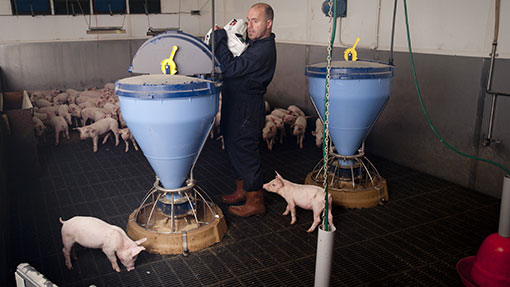Housing issues cause losses of £224 a sow a year

Pig producers could gain an additional £224 a sow a year by improving their environment to ensure pigs meet their genetic potential.
On average, pigs only realise 35% of their genetic potential in comparison to 75% for chickens.
This is largely due to a widening gap between genetics and unit environments, Stephen Waite, JSR head of technology, told delegates at the 25th and final JSR Farming Conference.
He explained cheap pig housing is not always the best option for long-term profitability.
“When someone builds a new-build, they like building it with minimum water access, minimum feed space and minimum floor space. They do that because that’s the cheapest. But minimums don’t change with genetic progress.”
Dr Waite said environment governed how well genetic potential is reached and genetics performed very differently in different environments.
He highlighted three areas of production where pig environment could be improved to boost performance: farrowing, nursery and finishing.
Farrowing
The number of piglets born a sow was higher if they were served at the optimum temperature, he explained.
One farm situation he highlighted was where the temperature at service rose above 14C during the summer months, the average number of piglets born fell.
Dr Waite explained when the temperature was uncontrolled, the number of piglets born averaged 11.5, but when the temperature was controlled below 14C, the number of piglets born alive rose to 13.3.
This equated to £80 extra profit a gilt a year for four more piglets sold, he said.
Nursery
Creep feeding trial work conducted by JSR demonstrated that switching from feeding piglets four-times-a-day to ad-lib improved feed intakes by 400%.
Dr Waite said this resulted in a 1.3kg uplift in weights at weaning worth £2 a pig.
Finishing trials
At Harper Adams University College, finishing pigs were fed to weight, which resulted in an FCR of 1.97 (the Bpex average is 2.4).
Total gained
Farrowing – £80 extra profit a sow a year by weaning four more pigs at £20 each
Nursery – £2 x 22 (number of piglets sold a sow a year) = £44 a year
Finishing – £5 x 20 (number of piglets sold a sow a year) = £100
TOTAL: £224
Dr Waite calculated the 0.23 FCR improvement was worth £5 a pig and he said the total that can be gained for these overall improvements is £224 a sow (see box, right).
“Better control of pig environments is already available through technology.
“You can tailor your environment to make more out of genetics. On farms with total control units, you see mirror growth curves,” he said.
But he warned it is impossible to make improvements without measuring performance.
He added: “Small changes really can have a big impact.”

